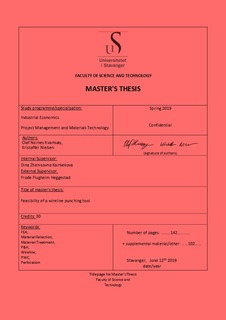| dc.description.abstract | This thesis describes the process of the development work completed for E Plug AS. A feasibility study on a downhole punching tool has been conducted. Furthermore, a simulation model has been created and evaluated through testing.
Throughout the project, several tests on different punching geometries have been conducted. These tests have resulted in essential knowledge regarding how different shear geometries behave when punched through a casing. Additionally, these tests have been used to verify hand calculations and highlight any deviations. The results show a promising correlation for simple geometries, while being inaccurate for com-plex geometries with varying shear areas throughout the punching process.
A material model has been established from specimina obtained from a L80 casing. This material model has been used to generate a FEA model, enabling iterative de-sign evaluations of different punch geometries. Different punch geometries were de-signed, produced and tested to verify the accuracy of the established FEA model. The correlation between hand calculations, test results and FEA is proven to be satisfac-tory for further development of the punch head.
Moreover, this thesis includes a study of materials, coatings and treatments of com-ponents for tool optimisation. Conclusions are not made, but recommendations for further testing and evaluation are presented. These recommendations involve du-plex treatments consisting of nitriding as a base layer with PVD applied nitride com-pounds for the punch head. Similarly, a nitride base layer with PVD applied transition metal dichalcogenide monolayers as solid lubrication is recommended for sliding surfaces.
In addition to the technical aspect of the thesis, the market needs, economic bene-fits and risk induced by developing the tool has been researched. Preliminary results obtained through questionnaires and literature, show that it might be a significant risk-reducing contributor in certain aspects of P&A. This is a result of guaranteed perforation of the inner casing only, good topside control and no explosives. How-ever, reasonable estimates on cost reduction or income potential for the tool is hard to establish due to restricted information and variations in well design. | nb_NO |
